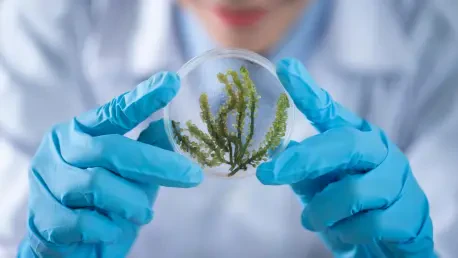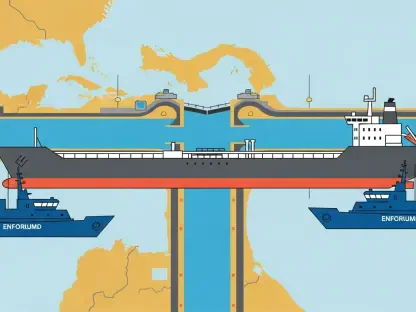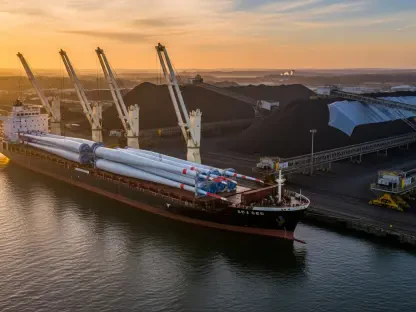In a world grappling with the urgent need to slash carbon emissions, the race for sustainable energy solutions has taken center stage, particularly in heavy transport sectors like aviation and shipping, which are notorious for their high greenhouse gas output. These industries are increasingly turning to biofuels such as sustainable aviation fuel (SAF) and renewable diesel to meet stringent decarbonization targets. However, the backbone of current biofuel production—waste lipids like used cooking oil (UCO) and animal fats—faces a critical supply shortage that could derail progress. As global demand for alternative fuels surges, the industry finds itself at a crossroads, searching for scalable and environmentally friendly feedstocks to bridge the gap. Microalgae, tiny photosynthetic organisms, have emerged as a potential game-changer in this landscape. Capable of growing in diverse conditions without competing for arable land, they offer a tantalizing glimpse into a future where biofuels align seamlessly with sustainability goals. What sets these microscopic entities apart, and can they truly address the looming challenges in the energy sector?
The Biofuel Industry’s Current Landscape
Growth and Reliance on Waste Lipids
The alternative fuels sector is experiencing unprecedented growth, driven by global imperatives to reduce emissions in hard-to-abate industries. Projections from GlobalData suggest a robust compound annual growth rate (CAGR) of 16% from 2025 to 2030, with capacity expected to double by the decade’s end. This expansion owes much to waste lipids, which have become the preferred feedstock due to their high lipid content and straightforward conversion processes. These materials, including UCO and animal fats, benefit from established collection networks and lower processing costs compared to more complex biomass alternatives. Policy frameworks like the EU’s Renewable Energy Directive (RED III) and California’s Low Carbon Fuel Standard further bolster their use by assigning favorable carbon-intensity scores, incentivizing manufacturers to prioritize them. This dominance, however, masks a growing concern about long-term viability as the industry scales up to meet ambitious environmental targets.
Despite the current success of waste lipids, their widespread adoption highlights a dependency that could hinder future progress. With 65 plants worldwide utilizing UCO and projections estimating animal fat usage at 5.6 billion gallons annually by 2030, the sheer volume underscores their critical role. Yet, this reliance is a double-edged sword, as these resources are deeply tied to food systems and face competing demands from other sectors. The finite nature of waste lipids means that supply cannot keep pace with the skyrocketing needs of the biofuel industry. Regulatory support, while beneficial in the short term, does little to address the underlying scarcity, pushing stakeholders to consider diversification. The urgency to find alternative feedstocks is becoming increasingly apparent, as continued dependence on limited resources risks stalling the momentum of decarbonization efforts in critical transport sectors.
Supply Challenges and the Push for Innovation
The limitations of waste lipids are becoming a focal point for industry analysts, with consensus forming around the inevitability of a feedstock transition by 2030 or beyond. The International Energy Agency (IEA) has cautioned that global UCO supply will likely never surpass 20 million tonnes per year, creating a bottleneck that threatens to cap the biofuel sector’s growth. This constraint is exacerbated by the fact that animal fats and other waste lipids are not exclusively available for fuel production, often being diverted to other industrial uses or food-related applications. Such competition for resources reveals the fragility of the current system, prompting a reevaluation of how the industry can sustain its upward trajectory. The recognition of these supply issues is driving a wave of innovation, as companies and policymakers alike seek out feedstocks that can offer both scalability and sustainability.
This push for innovation aligns with broader trends toward circular economy practices within the energy sector, where waste minimization and resource efficiency take precedence. Analysts from GlobalData and the IEA emphasize that while waste lipids will likely remain dominant in the near term, their role as a long-term solution is untenable. This realization has sparked significant interest in alternative biomass sources that can complement or eventually replace current feedstocks. Among these, microalgae have garnered attention for their potential to address supply constraints without the ethical or logistical drawbacks of crop-based biofuels. The shift toward such novel solutions reflects a growing acknowledgment that sustainable energy production must evolve beyond temporary fixes, embracing feedstocks that can support a decarbonized future without compromising other societal needs.
Microalgae as a Game-Changer
Unique Advantages Over Traditional Feedstocks
Microalgae stand out in the realm of biofuel production due to their remarkable environmental benefits and adaptability to diverse cultivation conditions. These microscopic, single-celled organisms, typically ranging from 1 to 10 micrometers in size, possess the unique ability to absorb carbon dioxide (CO₂) during photosynthesis, directly contributing to emissions reduction. Unlike traditional feedstocks such as palm or soybean oil, microalgae do not compete with food production, sidestepping the contentious “food versus fuel” debate that has long plagued the industry. Their cultivation can occur on non-arable land or in controlled environments like ponds and photobioreactors, minimizing conflicts over land use and preserving valuable agricultural space. This characteristic positions microalgae as a sustainable option that aligns with global decarbonization goals, offering a pathway to scale up biofuel production without sacrificing other critical resources or ecosystems.
Beyond their environmental alignment, microalgae bring a level of versatility and scalability that sets them apart from waste lipids and other biomass sources. Their even distribution across various climates and ability to thrive in settings unsuitable for conventional crops make them a viable feedstock for widespread adoption. Additionally, the high lipid content in certain strains of microalgae mirrors the technical advantages of waste lipids, easing the transition for biofuel processors accustomed to lipid-based inputs. However, despite these promising attributes, the technology surrounding their cultivation and processing remains in its early stages. Barriers such as the need for precise environmental controls—light, temperature, and CO₂ supply—add layers of complexity to their integration into mainstream production. Nevertheless, the inherent strengths of microalgae signal their potential to redefine how the industry approaches sustainable fuel development over the coming decades.
Pilot Projects and Future Potential
Real-world applications of microalgae cultivation are already providing valuable insights into their practical feasibility, even as they highlight persistent challenges. The EU-funded All-gas project in Chiclana, Spain, exemplifies this potential by using municipal wastewater as a nutrient source for growing microalgae, effectively integrating waste management into biofuel production. This initiative not only reduces cultivation costs by repurposing waste but also demonstrates how microalgae can contribute to circular economy principles by turning byproducts into valuable resources. Similarly, the FUELGAE project, backed by €5 million in EU funding, is piloting algae production at industrial sites in Romania and Spain, targeting advanced biofuels for high-emission sectors like aviation. These early efforts underscore the technical promise of microalgae, showing that they can be woven into existing industrial and urban systems to create more efficient supply chains.
However, the path to commercial viability for microalgae is fraught with financial and technical hurdles that temper short-term optimism. High production costs, driven by energy-intensive processes such as centrifugation and dewatering, remain a significant obstacle, as does the need for specialized infrastructure to maintain optimal growth conditions. Current estimates suggest that widespread adoption at an industrial scale may not occur until the mid-2030s or even 2040, reflecting the time required to refine technologies and drive down expenses. Overcoming these barriers will necessitate sustained investment, government support, and collaborative innovation across sectors. While pilot projects like All-gas and FUELGAE lay critical groundwork, scaling these initiatives to meet global demand represents the next frontier. The long-term vision for microalgae hinges on addressing these challenges, paving the way for their emergence as a cornerstone of a decarbonized energy landscape in the years ahead.









